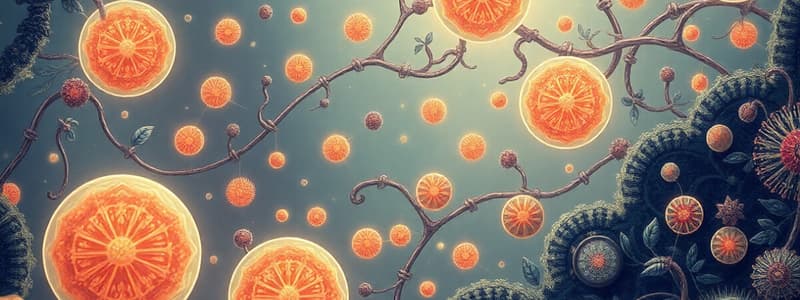Podcast
Questions and Answers
Flashcards
Which hormone promotes glycogen synthesis?
Which hormone promotes glycogen synthesis?
A hormone that primarily promotes glycogen synthesis, aiding in the storage of glucose in the liver and muscles.
What converts glucose 6-phosphate to glucose 1-phosphate?
What converts glucose 6-phosphate to glucose 1-phosphate?
An enzyme that catalyzes the conversion of glucose 6-phosphate to glucose 1-phosphate, essential for glycogen synthesis and breakdown.
Which vitamin is NOT a PDH complex coenzyme?
Which vitamin is NOT a PDH complex coenzyme?
A vitamin that is NOT a coenzyme in the pyruvate dehydrogenase (PDH) complex, which is crucial for converting pyruvate to acetyl-CoA for the citric acid cycle.
What citric acid cycle reaction produces FADH2?
What citric acid cycle reaction produces FADH2?
Signup and view all the flashcards
What's a unique characteristic of ketone bodies?
What's a unique characteristic of ketone bodies?
Signup and view all the flashcards
What's the role of bile salts in lipid processing?
What's the role of bile salts in lipid processing?
Signup and view all the flashcards
Which hormone stimulates bicarbonate release?
Which hormone stimulates bicarbonate release?
Signup and view all the flashcards
What's the role of Complex II in electron transport?
What's the role of Complex II in electron transport?
Signup and view all the flashcards
What's the main role of the inner mitochondrial membrane?
What's the main role of the inner mitochondrial membrane?
Signup and view all the flashcards
Where are hormones primarily produced?
Where are hormones primarily produced?
Signup and view all the flashcards
What's the impact of a citrate synthase mutation?
What's the impact of a citrate synthase mutation?
Signup and view all the flashcards
Which enzyme malfunctions in succinate to fumarate conversion?
Which enzyme malfunctions in succinate to fumarate conversion?
Signup and view all the flashcards
Why is ATP production reduced in a Complex IV defect?
Why is ATP production reduced in a Complex IV defect?
Signup and view all the flashcards
Why is ATP production impaired in a Complex III defect?
Why is ATP production impaired in a Complex III defect?
Signup and view all the flashcards
How many NADH molecules are produced in beta-oxidation of a 16-carbon fatty acid?
How many NADH molecules are produced in beta-oxidation of a 16-carbon fatty acid?
Signup and view all the flashcards
Which enzyme catalyzes the first step of glycerol conversion?
Which enzyme catalyzes the first step of glycerol conversion?
Signup and view all the flashcards
Where does the urea cycle primarily happen?
Where does the urea cycle primarily happen?
Signup and view all the flashcards
Which enzyme initiates glycogen breakdown?
Which enzyme initiates glycogen breakdown?
Signup and view all the flashcards
What type of receptor does insulin bind to?
What type of receptor does insulin bind to?
Signup and view all the flashcards
What hormonal imbalance contributes to high blood glucose and triglycerides?
What hormonal imbalance contributes to high blood glucose and triglycerides?
Signup and view all the flashcards
What does NOT regulate PDH complex activity?
What does NOT regulate PDH complex activity?
Signup and view all the flashcards
Which enzyme is linked to NADH reduction?
Which enzyme is linked to NADH reduction?
Signup and view all the flashcards
Which electron carrying molecule does the heme group belong to?
Which electron carrying molecule does the heme group belong to?
Signup and view all the flashcards
Which citric acid cycle enzyme doubles as a respiratory chain complex?
Which citric acid cycle enzyme doubles as a respiratory chain complex?
Signup and view all the flashcards
Which lipoprotein component activates LPL in the capillary?
Which lipoprotein component activates LPL in the capillary?
Signup and view all the flashcards
What disease could a biotin deficiency cause?
What disease could a biotin deficiency cause?
Signup and view all the flashcards
What enzyme is triggered first during vigorous muscle activity?
What enzyme is triggered first during vigorous muscle activity?
Signup and view all the flashcards
What is the starting point of the glycogenin mechanism?
What is the starting point of the glycogenin mechanism?
Signup and view all the flashcards
Which zymogens are activated by trypsin?
Which zymogens are activated by trypsin?
Signup and view all the flashcards
What statement about beige adipocytes is FALSE?
What statement about beige adipocytes is FALSE?
Signup and view all the flashcards
What is the purpose of phosphoglucomutase in glycogenolysis?
What is the purpose of phosphoglucomutase in glycogenolysis?
Signup and view all the flashcards
Which nucleotide commits glucose to glycogen synthesis?
Which nucleotide commits glucose to glycogen synthesis?
Signup and view all the flashcards
What effect does ATP have on the PDH complex?
What effect does ATP have on the PDH complex?
Signup and view all the flashcards
Which coenzyme is not used in the citric acid cycle?
Which coenzyme is not used in the citric acid cycle?
Signup and view all the flashcards
Where are ketone bodies created?
Where are ketone bodies created?
Signup and view all the flashcards
What molecule is on the inner side of the mitochondrial membrane for fatty acid transport?
What molecule is on the inner side of the mitochondrial membrane for fatty acid transport?
Signup and view all the flashcards
Which amino acid is key for amino acid oxidation?
Which amino acid is key for amino acid oxidation?
Signup and view all the flashcards
What's the purpose of Complex I in oxidative phosphorylation?
What's the purpose of Complex I in oxidative phosphorylation?
Signup and view all the flashcards
What's the purpose of heme b in complex II?
What's the purpose of heme b in complex II?
Signup and view all the flashcards
Which hormones are found in the liver?
Which hormones are found in the liver?
Signup and view all the flashcards
How does glucose-6-phosphate inhibit hexokinase?
How does glucose-6-phosphate inhibit hexokinase?
Signup and view all the flashcards
What accumulates during muscle contraction to accelerate glycogen breakdown?
What accumulates during muscle contraction to accelerate glycogen breakdown?
Signup and view all the flashcards
Which molecules act as allosteric activators of glycogen phosphorylase in muscles?
Which molecules act as allosteric activators of glycogen phosphorylase in muscles?
Signup and view all the flashcards
Study Notes
Hormone Function in Glycogen Synthesis
- Insulin primarily promotes glycogen synthesis.
Enzyme Converting Glucose 6-Phosphate to Glucose 1-Phosphate
- Phosphoglucomutase converts glucose 6-phosphate to glucose 1-phosphate.
Vitamin NOT a PDH Complex Coenzyme
- Vitamin C is not a coenzyme in the PDH complex.
Citric Acid Cycle Reaction Producing FADH2
- The oxidation of succinate to fumarate produces FADH2 in the citric acid cycle.
Unique Characteristic of Ketone Bodies
- Ketone bodies can cross the blood-brain barrier.
- They are produced primarily in the liver, not adipose tissue.
Bile Salts Role in Lipid Processing
- Bile salts emulsify dietary lipids in the intestine.
Hormone Stimulating Bicarbonate Release
- Secretin stimulates bicarbonate release from the pancreas.
Role of Complex II in Electron Transport Chain
- Complex II oxidizes succinate to fumarate, transferring electrons to ubiquinone.
Inner Mitochondrial Membrane Role
- The inner mitochondrial membrane regulates the transport of specific molecules.
- It's a barrier, housing enzymes for glycolysis.
Citrate Synthase Mutation Impact
- A genetic mutation affecting citrate synthase impairs the citric acid cycle.
- This leads to fatigue and reduced ATP production, as oxaloacetate cannot combine with acetyl-CoA.
Succinate to Fumarate Conversion Enzyme
- The enzyme catalyzing the conversion of succinate to fumarate is succinate dehydrogenase
ATP Production Reduction in Complex IV Defect
- A defect in Complex IV of the electron transport chain reduces ATP production.
- This is because NADH cannot transfer electrons to the chain.
- This prevents the proton gradient from forming properly.
Complex III Defect Impact
- A defect in Complex III reduces ATP production.
- The reduced ATP production is due to electrons failing to reach oxygen.
- Preventing proton pumping creates a low AG gradient.
High Ketone Levels and Fatty Acid Oxidation
- A 16-carbon fatty acid undergoing beta-oxidation and entering the citric acid cycle yields 23 NADH molecules.
Glycerol Conversion to Glycolytic Intermediate
- Glycerol kinase converts glycerol into a glycolytic intermediate.
Urea Cycle Location
- The urea cycle primarily occurs in the liver.
Enzyme Initiating Glycogen Breakdown
- Glycogen phosphorylase initiates glycogen breakdown.
Insulin Receptor for Glucose Uptake
- The insulin receptor involved in glucose uptake is a G-protein coupled receptor (GPCR).
Hormonal Imbalance in Elevated Blood Glucose & Triglycerides
- An imbalance of decreased insulin and increased glucagon activity is a likely contributing factor.
PDH Complex Regulation
- The PDH complex activity isn't regulated by fatty acid prevalence.
- It's regulated by ratios of ATP/ADP and NADH/NAD+.
- It's also regulated by Zn2+ and Ca2+.
Enzyme Linked to NADH Reduction
- Malate dehydrogenase is linked to the reduction of NADH.
Heme Group Belonging to an Electron Carrier
- Heme belongs to a-type cytochrome.
Enzyme in Citric Acid Cycle and Electron Transport Chain
- Succinate dehydrogenase is involved in both the citric acid cycle and the electron transport chain.
Lipoprotein Lipase Activation & Triglyceride Conversion
- Lipoprotein lipase is activated by apoC-II in the capillaries or apoC-II in the small intestine.
- It converts triacylglycerols into fatty acids and monoacylglycerols.
Biotin Deficiency Disease
- A biotin deficiency can lead to fatty liver disease.
Enzyme Triggered by Vigorous Muscle Activity
- Glycogen phosphorylase a is the first enzyme triggered by vigorous muscle activity.
Glycogenin Mechanism
- The glycogenin mechanism begins with the formation of a glycosidic bond between the glucose of UDP-glucose and a tyrosine (Tyr) group of glycogenin.
Zymogens Activated by Trypsin
- Trypsin activates trypsinogen.
- Trypsin also activates precarboxypeptidases A and B.
Beige Adipocytes Characteristics
- Beige adipocytes can be converted by cold exposure.
- Beige adipocytes are much richer in mitochondria than white adipocytes.
- They produce uncoupling protein 1 (UCP1).
Phosphoglucomutase Role in Glycogenolysis
- Phosphoglucomutase converts glucose-1-phosphate to glucose-6-phosphate.
- This allows for glucose to be used in other processes.
Glycogen Synthesis Nucleotide
- UTP is the nucleotide used for glycogen synthesis.
ATP Effect on PDH and Citric Acid Cycle
- ATP inhibits PDH kinase allowing PDF to function and the citric acid cycle to continue.
Citric Acid Cycle Coenzyme
- B6, CoA, and FAD are coenzymes used in the citric acid cycle.
Ketone Body Production Location
- Ketone bodies produced in the liver.
Fatty Acid Oxidation Mitochondrial Membrane Molecule
- Carnitine acyltransferase I is found on the inner side of the mitochondrial membrane.
Glucose-6-Phosphate Inhibition of Hexokinase
- Glucose-6-phosphate inhibits hexokinase by allosteric feedback inhibition; it binds at a site other than the active site.
Studying That Suits You
Use AI to generate personalized quizzes and flashcards to suit your learning preferences.




